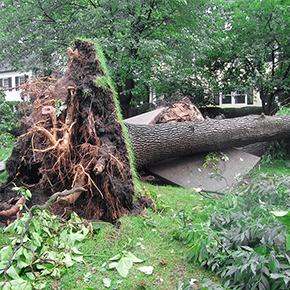
The Vital Importance of Strong Tree Root Systems
A strong root system is essential to maintaining a healthy tree. Roots have several very important functions for a tree:
They harvest and bring nutrients and water from the soil to the other parts of the tree
They anchor the tree in the ground and create stability, especially as a tree grows higher.

They help determine a tree’s alignment spatially.
They interact with the soil through microbial life which extends the ability of the root system to gather water and nutrients
The importance of a good root system can certainly be noticed after big storm systems come through an area. Wet soils and high winds usually result in many tree failures. This doesn’t have to be so, if we understand the importance of root systems to the tree and have a basic idea of things we can do to protect and encourage roots to properly develop. Tree roots normally grow larger and wider underground than the tree’s entire canopy above the ground. Therefore, preserving and enhancing as much of a tree’s natural root area should be one of the highest priorities in managing an urban forest.
However, since the root system underground it is often forgotten component of tree management, we often see tree failures during a storm. Compromised root systems from root diseases, compacted soil and improper watering are the three primary reasons we see trees failing. Over time as a tree matures, its roots are more subject to decay and rot. Since we can’t see this, we often don’t know until the tree fails. Compacting the soil near a tree canopy (by driving or even repeated mowing) and watering incorrectly encourage shallow roots and can increase the decay of tree roots.
A few simple maintenance and preventative measures can help ensure the long-term health and welfare of the trees you manage.
First – maintain a good layer of mulch over the root area. Going out as far as the tree canopy edge is ideal, but minimally going half way out will make a big difference. Next maintaining the right amount of water is critical. Soil that is too dry will slowly starve a tree; soil that is too wet can lead to rotting. Both conditions can make a tree more susceptible to disease and infestation. Lastly reducing soil compaction and encouraging a healthy soil and soil microbial life is critical to the long-term maintenance of the root systems.
Having strong tree root systems means having underground tree root systems. If you see some root exposure and aren’t sure if something needs to be done to address it, contact us and we’ll be happy to examine the situation and discuss it with you.
When your trees have their regular inspection by a professional, the roots are one of the areas that they’ll explore and test for health. One thing they will go over is what is going on around a tree that might impact its roots—are there other trees nearby? What other plants are in the area? Are there other stresses the tree is exposed to? Finally, – is the root system of the tree the best that is can be, and getting the best treatment it can? If not, your arborist will begin a discussion about the best ways to strengthen the root system of the tree and maintain those gains throughout the life of the tree.
Strong tree root systems represent an investment in your property, in the health and safety of your trees, and the continued health of the plants in your landscape. These organic anchors and transport systems are what make it possible to have beautiful, beneficial trees near our homes and businesses, and in public parks. By treating the starting point of our trees right, we can ensure that they provide us with years of beauty, shade, fresh air, and increased property values.